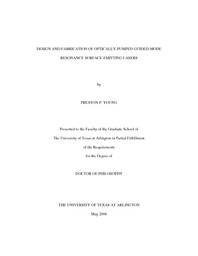
ATTENTION: The works hosted here are being migrated to a new repository that will consolidate resources, improve discoverability, and better show UTA's research impact on the global community. We will update authors as the migration progresses. Please see MavMatrix for more information.
Show simple item record
| dc.contributor.author | Young, Preston Phillip | en_US |
| dc.date.accessioned | 2007-08-23T01:56:45Z | |
| dc.date.available | 2007-08-23T01:56:45Z | |
| dc.date.issued | 2007-08-23T01:56:45Z | |
| dc.date.submitted | May 2006 | en_US |
| dc.identifier.other | DISS-1300 | en_US |
| dc.identifier.uri | http://hdl.handle.net/10106/444 | |
| dc.description.abstract | This dissertation describes the design and fabrication of guided-mode resonance (GMR) structures and their applications to laser devices. These include tunable Ti:Sapphire lasers as well as semiconductor lasers with integrated light emitting layers. The resonance characteristics of GMR structures are determined by the designed and fabricated waveguide-grating parameters. The primary tool for the design and simulation analysis of GMR devices is rigorous coupled-wave analysis (RCWA). This numerical method is used to provide diffraction efficiency calculations as well as simulations of the electric fields within GMR structures. RCWA-based field analysis is used to design an optically pumped GMR surface-emitting laser (GMR-SEL) in the GaAs/AlxGa1-xAs material system with an In0.2Ga0.8As quantum well for output wavelength near 980 nm.
All optical GMR devices require patterning of sub-micron diffraction grating structures. Preliminary GMR grating fabrication is performed by holographic interference lithography and is optimized by utilizing a charge-coupled device (CCD) camera-based fringe stabilization system. Prototype GMR-SEL devices are fabricated in the GaAs/AlxGa1-xAs material system by electron-beam lithography and reactive-ion etching (RIE). Electron-beam lithography is performed using hydrogen silsesquioxane (HSQ) as high-resolution resist material. The results of exposure proximity correction for electron-beam lithography are presented. An RIE process suitable for reliable etching of the HSQ grating patterns into a semiconductor GMR-SEL wafer is developed and characterized.
The fabricated prototype GMR-SEL devices are optically pumped at an oblique GMR resonance angle near 45º corresponding to the 810 nm output of a Ti:Sapphire laser. Whereas these elements have insufficient gain for lasing, the measured photoluminescence spectra for several devices exhibit spectral peaks that occur precisely at the theoretical GMR-SEL resonance locations. Therefore, this dissertation provides results and methods useful to experimentally realize prototype GMR-SEL devices fabricated in semiconductor materials. | en_US |
| dc.description.sponsorship | Magnusson, Robert | en_US |
| dc.language.iso | EN | en_US |
| dc.publisher | Electrical Engineering | en_US |
| dc.title | Design And Fabrication Of Optically-pumped Guided-mode Resonance Surface-emitting Lasers | en_US |
| dc.type | Ph.D. | en_US |
| dc.contributor.committeeChair | Magnusson, Robert | en_US |
| dc.degree.department | Electrical Engineering | en_US |
| dc.degree.discipline | Electrical Engineering | en_US |
| dc.degree.grantor | University of Texas at Arlington | en_US |
| dc.degree.level | doctoral | en_US |
| dc.degree.name | Ph.D. | en_US |
| dc.identifier.externalLink | https://www.uta.edu/ra/real/editprofile.php?onlyview=1&pid=2434 | |
| dc.identifier.externalLinkDescription | Link to Research Profiles | |
Files in this item
- Name:
- umi-uta-1300.pdf
- Size:
- 28.22Mb
- Format:
- PDF
This item appears in the following Collection(s)
Show simple item record


